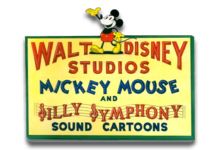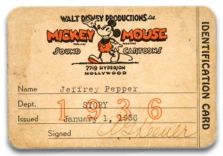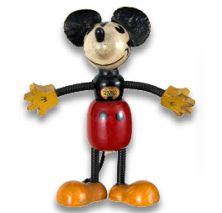What follows may rate as a bizarre exercise in nostalgia, if you will permit it. It deals with issues which may upset some people, and so if you do elect to read it I most humbly suggest that it be read wth a whimsical and open mind as I will attempt to faithfully relate the colorful stories and myths as they were first told to me which make up such a vital part of the oral tradition of the Walt Disney World "underground". So much of this tradition is unrecorded and so the reader may, as she chooses, read the following merely as an account of the superstitions and urban legends which circulate through breakrooms and utilidors. Those of us who worked there, however, will probably never be as sure...-----
"The most famous faux fatality was 'George', the imaginary welder who was killed during the construction of Pirates of the Caribbean... [...] The imaginary victim is most likely a Disneyified amalgam of the actual fatalities at Disney World.." - David Koenig,
Realityland, pg. 144
The first day I ever walked into Pirates of the Caribbean was a bright Florida winter morning in 2005. I don't mean I rode it - I walked into it, through a tunnel, around a large pool of water, opened a door which looks so real and textured from the boats but is really a painted plywood flat, and was looking right at a grotesque mannequin of a fat woman. She has no legs, just a pole extending up into her body, and up close the already garish makeup was like a clown's face. The building was quiet and still, the water glassy and calm, and the figures were twitching. Those things move after they're turned off, and sort of spasm occasionally at the wrist or neck. But the eeriest thing was the silence - it isn't until you've seen a Disney park utterly abandoned and quiet and left to the painters and pressurewashers and mechanics that you realize that they aren't places for human beings, and that all that warmth you feel in the bright light of day comes from that reassuring music, the faces, the people. Under worklights and powered down, those attractions are more like ghost houses, museums staffed by nobody for a crowd that may never return.
Eventually a voice issued from the PA system: "Good morning, George."

On page 144 of
Realityland, David Koenig reveals a fact which I have long suspected, which is that in his years of research he has failed to find any mention of a fatality regarding the construction of Pirates of the Caribbean, the death of a young man named George. Since Koenig's research is otherwise maddeningly complete regarding all manner of death and dismemberment at Walt Disney World, I have no reason to doubt him. However, that does not remove the fact that for us working at Pirates of the Caribbean then and, I'm sure, to the Cast Members working there today, George was a day to day reality. He has a way of making a believer of you. A day of constant and inexplicable breakdowns, a door that will not open for you and only you, or the strange way you often feel followed while crossing one of the attraction's many crosswalks, eventually you will meet George. Who he really is and why he responds as "George" will probably forever be a mystery.
George, the typical story goes, was a young man who, while welding or perhaps bolting a high area of the superstructure of the building which would one day become Pirates of the Caribbean, met with a horrible accident and fell to his death. From day one of the operation of the attraction - December 15, 1973 - inexplicable events plagued the attraction. Breakdowns were constant and unmotivated. Female castmemebers were mysteriously patted on their rear or had their bra straps snapped. Stories of George grew. In the early years, it is said that an old woman would often enter the ride and ask for a boat to herself. On the in-ride security cameras, she could be seen weeping and talking to nobody. Eventually, it was discovered that she was talking to her son - George.

A second component of the story comes into play surrounding the downramp, or waterfall, and it is partially confirmed by Koenig on page 144 of
Realityland - although his version differs significantly from the version traditionally told. At the very bottom of the downramp, the boats take a sharp left turn to proceed into the show building. This turn is the single point the sides of the metal troth the boats ride through during the attraction poke above the water... although it is a hazard for any hand trailing in the water, the boats are safely steered through the "downramp runoff" area and into the famous scene of the pirate ship attacking the fort known as Bombardment Bay. Legend tells us that for a few months these raised metal guides were not present, which resulted in one particularly light boat hitting the bottom of the drop, hydroplaning out of the troth, and killing two women sitting in the front row. Whether by George or by fate, "The Ladies" entered into myth and became perhaps the most feared inhabitants of Pirates of the Caribbean.
George casts a long shadow over the Cast imagination. The town scenes which constitute the bulk of the Florida version of the show are contained in a single, huge room which has a large, central pillar supporting its' roof. The top of this pillar is decorated to appear to be a multi-windowed tower, and can be seen to the right of Carlos' house in the Well scene. If you are lucky, you may even see a lonely little light burning in it. This pillar is supposedly the one which George fell from, and his initials, carved on the bottom of the pillar, cannot be painted over - they will bleed through the paint. The tower is called "George's Tower" - a play on the term for the ride's central control booth overlooking the Load area, called "Tower" - and has a special trick to it. If one sees a light burning in George's tower from the Well scene, it means that George is "home". If you get to the fire scene and look back up to George's Tower (the two scenes are only a few feet away from each other, on the other side of the village facades), and if that light is still burning in George's Tower - it often is not - then something bad is about to happen.
I've been to the bottom of that pillar, and can verify that it does indeed feature a set of initials, a G followed by perhaps a C. It also features dozens of other bits of graffiti, and cannot vouch for their ability to bleed through paint without the aid of a less ghostly agent. I have, however, seen the light in George's Tower go through its' disappearing and reappearing act many times and cannot account for its' cause. As the tower is some many dozen feet up, I was not about to climb the ladder and see if there's really a light installed up in that tower or not. I suspect that there is none; not even at Disney are lighting fixtures so unreliable that the tower is dark more often than not.

Continuing from the base of George's Tower, and proceeding further into the show building, one comes across an inauspicious set of steps which lead up to a door. On the "show scene" side of the door is the famous dog, keys dangling from mouth. This door is George's Door, and it must be closed at all times. If George's Door is left open, the ride should not be powered up in the morning. This is fine for show quality reasons in the morning, and building maintainence and Imagineering know well enough to shut it behind them. However, sometimes, the door begins the day shut and will, in the middle of the day, mysteriously creak open.... and if George's Door is open, it is said, a serious breakdown is sure to follow. As you can imagine, if the light is on in George's Tower
and George's Door is open, it is considered to be an especially bad portent.
George is, for whatever reason, especially active in that part of the building, perhaps because it is indeed the most far-flung and least traversed portion of the ride. He seems to especially lurk around "Storage", which is a spur line that runs underneath the burning city show scene where boats may be moved on or off the main ride path in order to be sent to or released from the maintainence bay. The spur line begins at the end of the chase scene near "Old Bill", a figure who was in fact designed by Marc Davis especially for the Walt Disney World show so that audiences would not notice an unusually long gap in the ride; the figure was cloned and placed in a similar spot for the Disneyland show later on and the pacing of the gag is not as effective there as a result since at Disneyland "Storage In" is at the Bombardment Bay scene. Storage Out is near the Jail scene, and if you're one of many who sometime feel a little uneasy after going under the pirate with the hairy leg and before coming upon the Jail; you may have had an encounter with George. He especially seems to be near that particular bend in the track, close to his door. Behind the faux stone show walls, a few feet down, is the cement foundation of the building. To facilitate dry passage along the edge of the spur line is a number of plastic grates laid across the floor, which is often flooded with a bit of water. Many have crossed these grates during an evacuation or during after-hours events where Cast are stationed in the ride to watch guests and heard the second pair of feet walking behind them a few grates back, and even felt cold breath on their neck. On the opposite end of the spur line, a shadowy man is sometimes seen sitting in a prop chair near Old Bill, or crossing the bridge which divides the Chase scene from the Fire scene - an impossibility since such an action would set off several alarms.
I don't feel the need to comment too much on the customary habit of saying good morning and goodnight to George, as this is famous and needs little further explanation at this point.

What a textbook account of all these customs, traditions and/or superstitions fails to convey is the day-to-day nature of the 'reality' of George. The morning and evening greetings were in fact nearly mandated by management, and any deviation will result in the day's woes being explicitly blamed on the closing Cast Member in Tower of a previous night. Switches, doors, water sensors and other basic mechanics sometimes inexplicably malfunction, causing the ride computer to enter "cycle out" mode - the Load Area gates lock and the computer enters a countdown until it will shut down the ride. This will initiate the regulated but still mad dash to fix the ride with as little disruption to the operation as possible - and resulting in the single most feared task by any new Cast Member, the need for the Unload cast member to enter the ride building and re-open, or "key", the Downramp.
The Downramp is designed so that the bottom of the ramp must be opened before the top; just like a playground slide the bottom must be clear before the boat at the top can come down. This is facilitated with a key turned in a lock and, in order to reach the downramp, one must proceed on a labyrinth path through the guts of the building and emerge in what is known as the "Transition Tunnel". What follows is an endless-feeling wait in a very dark tunnel, and it is often here that your thoughts turn to those women in the front row of that very light boat.
I cannot here exaggerate when I say that those times I have spent at the bottom of the downramp, waiting to be called on the park phone by Tower, count as among the most miserable moments of my life. The mild illumination is not helpful, the water continues to rush past you, and you fully expect for a boat to turn the corner into sight at any moment, perhaps with two bloody figures seated in the front row. The walk to get to the downramp is traumatic, dimly lit and wet, with the chest-high wading pants used during ride evacuations slung every few feet over handrails providing a jolt, so easy are they to mistake for a just-noticed figure or dead, limb legs jutting from the shadows. At the bottom of the ramp, the atmosphere is oppressive - you expect to be jumped. Worst of all, the ear splitting volume of the ghostly narration which once echoed through this scene prior to the 2006 refurbishment:
No fear have ye of evil curses says you! Properly warned ye be, says I! DEAD MEN TELL NO TALES! Perhaps ye knows too much! Ye've seen the cursed treasure and you know where it be hidden... DEAD MEN TELL NO TALES!The Ladies generally confine themselves to this small portion of the ride, and although the tunnel has been significantly relieved in atmosphere by the removal of those damned voices and the insertion of the upbeat Hans Zimmer soundtrack, I still shudder as I pass by the hidden exit point, and I know that those two women still linger. George, however, may be observed anywhere, at any time. Odd white points of light occasionally float out of boats and into the rafters of the ride, observable only on security cameras. Shadows sometimes crawl along walls where you know they are not supposed to be. One spectacular and probably fictional manifestation I was once told about involves a cloud of mist engulfing a boat before it plunged down the downramp.
Guests sometimes report seeing "someone" looking down on them from the Bombardment Bay fortress, but even more uncanny things have happened, especially if the guest makes idle chat about George in the Load Area and proceeds through the ride alone in their boat. One guest questioned me at length about changes to the dialouge in the attraction until finally I realized that they were telling me that the voice which ordinarily says "Dead Men Tell No Tales" was in fact saying something about the dead "not having a face" and furthermore had felt that many of the ride figures were visibly malfunctioning and appeared to be looking at them! Of course, they had mentioned George's name several times to themselves while entering, and although we will never be fully sure of the truth of this story, it does make a delightfully spooky addition to George's tale. And if it matters at all, the guest seemed to be honestly confused rather than deceitful and left looking unsure. I, for one, had trouble standing down at Unload for the rest of the night. As such, it is recommended that all guests who mention or pretend to "talk to" George while on his ride, treat him with proper respect and say goodnight to him as they leave.

Although the refurbishment changed this, the queue at Pirates has two sides; what was then known as Load 1 and Load 2. Load 1 winds past the famous skeletons playing chess, while Load 2 headed through a once uncommonly seen portion of the queue, with a dining hall and cannon pit. Load 2, however, had been modified to include a wheelchair ramp out of the building, and late at night we would have to lead guests in wheelchairs down to this side of the load area, turn on the load console, load just that group into a boat, turn off the load console, and push the chair back out the exit ramp because Load 2 was considered the "secondary" side of the holding area. The designation has since been reversed, but on many trips exiting Load 2 with an empty wheelchair I knew George was loitering in this usually quiet part of the building. I even saw him once. He was all black, like a shadow standing off the wall. This is his most common description, so perhaps I really did see something...
I don't often get nostalgic for my days at Disney but pre-Jack Sparrow Pirates of the Caribbean is a wonderful memory for me, a time when the lines were often short, steel drum music echoed through the plaza, and a green parrot by the entrance would have to be muted five minutes before the start of the fireworks. And George was there, perhaps just in our minds, but constant none the less. But then again perhaps he was really there, you know. I'm sure inexplicable breakdowns persist to this day, and those plastic grates laid down all over the foundation of the show building which let you walk dryly even though the floor is usually slightly flooded, I'm sure that to this day you can hear another set of feet clanging across them, just a few feet behind you at that one special spot. His name may have been any number of things, but we called him George, and in a way he is the protector of Pirates of the Caribbean. More than a nuisance when his door isn't closed or he isn't greeted by name, we knew George wouldn't really do anything to hurt us and we knew he would protect any of us from really getting really hurt if necessary.
That was, at least, the hope...








































































